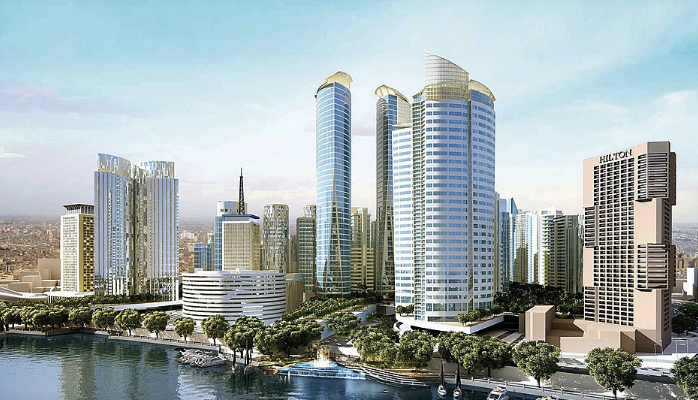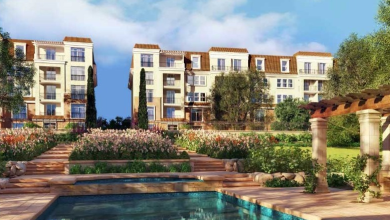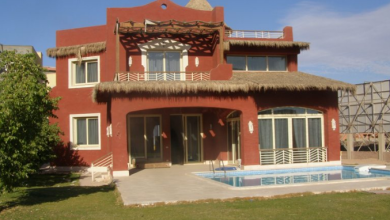
Executive Summary & Market Outlook
The Egyptian real estate market presents a compelling, albeit complex, investment thesis. Characterized by powerful demographic tailwinds, ambitious state-led mega-projects, and a dynamic economic environment, the sector offers significant opportunities for capital appreciation and rental income across its residential, coastal, and commercial segments.
Our analysis indicates the market is defined by a dual-engine growth model. On one hand, fundamental demand is driven by a young, rapidly growing population and accelerating urbanization. On the other, economic pressures, including high inflation and currency devaluation, have paradoxically fueled a surge in domestic investment, as local capital seeks refuge in tangible assets like Egypt Properties. For foreign investors, this creates a unique value proposition, where a devalued currency offers a lower cost of entry.
Key opportunities are concentrated in several high-growth corridors. In the urban residential sector, East Cairo, particularly New Cairo and the New Administrative Capital (NAC), is the epicenter of modern development. The coastal market is dominated by the North Coast‘s luxury leisure segment. Within commercial real estate Egypt, the industrial and logistics sub-sector emerges as the standout growth story, fueled by the structural shift towards e-commerce.
Leading real estate developers such as Mountain View, Talaat Moustafa Group (TMG), and Emaar Misr are not merely constructing buildings; they are shaping lifestyles and creating investment-grade products. The success of concepts like the “iVilla” underscores a market that is maturing to meet diverse consumer aspirations. However, success requires a granular understanding of each sub-market’s unique risk-reward profile. The long-term outlook remains decidedly positive, positioning Egypt as a key real estate hub in the Middle East and North Africa.
The Macro-Environment: Market Drivers & Headwinds
Market Growth and Core Catalysts
The Egyptian real estate market is on a trajectory of sustained and rapid expansion. While specific valuations vary, a consensus across multiple market analyses points to strong, near-double-digit compound annual growth rates (CAGR) for the coming years. Projections estimate the residential market alone could grow from approximately USD 21.95 billion in 2025 to USD 36.92 billion by 2030. The key takeaway for investors is this powerful, underlying momentum.
This growth is underpinned by several core catalysts:
- Demographics: A population exceeding 105 million with a high annual growth rate creates immense, fundamental demand for housing. Rapid urbanization further fuels the need for residential units and the supporting commercial ecosystem in cities like Cairo and Giza.
- Government Mega-Projects: The development of the New Administrative Capital (NAC) and New Alamein City are powerful economic anchors. They create new population centers that require a full spectrum of residential real estate, commercial services, and infrastructure, effectively de-risking large-scale private investment.
- Foreign Direct Investment (FDI): The government has actively courted international capital by easing property ownership regulations. This has attracted significant investment, particularly from the GCC, and brought in major international developers who provide capital and expertise.
The Investment Climate: Currency and Inflation

The investment climate is defined by the interplay of high inflation and currency devaluation. While these factors present risks, they have paradoxically catalyzed the domestic real estate market. For local investors holding wealth in Egyptian Pounds (EGP), real estate has become the preferred vehicle for wealth preservation and a hedge against inflation. This “flight to safety” creates a powerful internal demand loop, pushing nominal property values higher.
For foreign investors, the devalued pound offers a significantly cheaper entry point, creating the potential for outsized returns if the currency stabilizes. However, this opportunity is intrinsically linked to currency risk. A successful investment strategy must therefore account for these variables, weighing the potential for value against macroeconomic volatility.
Sector Deep Dive: Urban Residential Properties
Primary Hubs: East vs. West Cairo
Greater Cairo’s residential market is concentrated in two major corridors: East and West Cairo.
- East Cairo, encompassing New Cairo, the 5th Settlement, and the NAC, is the epicenter of modern development. Its proximity to the airport and the NAC, combined with a focus on high-quality, integrated communities like TMG’s Madinaty and Emaar’s Uptown Cairo, makes it the primary target for growth-focused investment.
- West Cairo, centered around 6th of October City and Sheikh Zayed, is a more established, mature suburban market. Preferred by affluent families and expats, it offers stability and a community-oriented lifestyle, with major developments from leading players like Mountain View iCity October and Palm Hills.
The choice for an investor depends on strategic goals: East Cairo offers higher growth potential linked to the NAC, while West Cairo provides the stability of a mature community.
Inventory of Residential Assets
The market offers a wide inventory of types of residential properties, from standard apartments, villas, and townhouses to more innovative products. The most prominent example is the iVilla, a concept pioneered by Mountain View. This duplex unit is designed to replicate the feel of a standalone villa—with a private entrance and garden or roof terrace—at a more accessible price point. Its success highlights a market shift towards sophisticated, branded products that cater to specific lifestyle aspirations.
Price Benchmarking in Key Urban Compounds
Pricing varies significantly based on location, developer brand, and unit type. The gap between off-plan and resale prices often indicates strong capital appreciation.
- Mountain View Hyde Park (New Cairo): An iVilla with a roof was listed on the resale market for EGP 13,250,000.
- Taj City (New Cairo): Resale iVillas command a premium, listed at EGP 11,500,000.
- City Gate (New Cairo): High-end villas command premium prices, ranging from EGP 40,500,000 to EGP 64,500,000.
- Mountain View iCity October (West Cairo): This project shows significant capital growth. Resale apartments can be found from EGP 4,000,000, while the developer’s current primary market price for similar units starts over EGP 9,000,000, underscoring the benefits of early, off-plan investment.
Sector Deep Dive: Coastal & Resort Properties
The North Coast (Sahel): Egypt’s Premier Luxury Market
The North Coast is Egypt’s undisputed premier destination for luxury leisure and coastal properties. Hotspots like Ras El Hekma and Sidi Abdel Rahman are being shaped by top developers including Emaar (Marassi), Palm Hills (Hacienda Bay), and Mountain View (Mountain View Ras El Hekma, LVLS).
The inventory is dominated by chalets and villas, with a vast pricing spectrum. While entry-level chalets exist, the focus is on luxury. Premium chalets can exceed EGP 20 million, while prime standalone villas regularly surpass EGP 50 million, with trophy assets reaching as high as EGP 125 million. This demonstrates the North Coast is an investment-grade luxury market. The investment landscape is stratified:
- Chalets: Represent the “mass luxury” market, offering a more accessible entry point. They are popular for buy-to-let investors seeking high seasonal rental income.
- Standalone Villas: Occupy the “ultra-luxury” segment, serving as trophy assets for HNWIs. The investment strategy here is focused on long-term capital appreciation.
The Red Sea (Ain Sokhna): The Year-Round Alternative
Ain Sokhna offers a distinct value proposition: its proximity to Cairo makes it an accessible, year-round weekend destination. This provides the potential for more stable and consistent rental yields compared to the highly seasonal North Coast. Developers like Mountain View and Tatweer Misr have a strong presence, offering projects like IL Monte Galala that cater to investors prioritizing cash flow stability.
Sector Deep Dive: The Commercial Real Estate (CRE) Frontier
The commercial real estate Egypt market is in a phase of dynamic transformation, driven by economic expansion, urbanization, and a flourishing tourism sector. The market is comprised of several distinct sub-sectors:
- Office Market: A “flight to quality” is evident, with strong demand for Grade A office space in well-planned business parks. The rise of hybrid work is also fueling demand for flexible and co-working spaces.
- Retail Market: A powerful trend towards formalization is underway, with growing demand for modern shopping malls and lifestyle centers that can accommodate international brands.
- Hospitality Market: A booming tourism industry is driving high hotel occupancy rates and significant new hotel development, particularly in Cairo and on the Red Sea.
- Industrial & Logistics: This is the breakout star of Egyptian CRE. The structural shift to e-commerce has created massive, non-negotiable demand for modern warehouses, distribution centers, and last-mile fulfillment hubs, making it the most compelling high-growth opportunity in the commercial space.
Developer & Project Showcase
Case Study: Mountain View
Mountain View has distinguished itself through scaled development, product innovation, and a people-centric brand philosophy. With over 20 projects across East Cairo, West Cairo, and the coasts, their portfolio is both diverse and strategically located. The company’s “experience-focused” approach is evident in its master planning, which prioritizes happy, vibrant communities. Their signature “iVilla” product is a testament to their ability to innovate and meet specific market needs. Projects like Mountain View iCity October exemplify their concept of a fully integrated city, offering a holistic living experience with a wide range of unit types and prices reflecting significant capital appreciation for early investors.
Profiles of Other Market Leaders
- Talaat Moustafa Group (TMG): A titan known for developing entire cities like Rehab City and Madinaty, creating massive, self-sustaining urban communities.
- Emaar Misr: The subsidiary of the Dubai-based giant, synonymous with ultra-luxury. Its projects, Uptown Cairo and Marassi on the North Coast, set the benchmark for premium development.
- Palm Hills Developments (PHD): One of Egypt’s largest developers with a vast, diversified portfolio, including the highly successful Hacienda brand on the North Coast.
- Coldwell Banker: While a brokerage, this global brand provides invaluable market intelligence on pricing and rental yields, crucial for investor due diligence.
Strategic Investment Framework & Recommendations
Comparative Investment Analysis Table
This table provides a structured framework for aligning investment goals with the most suitable asset classes in the Egypt Properties market.
| Investment Profile | Avg. Price Range (EGP) | Avg. Size (sqm) | Capital Appreciation Potential | Rental Yield Potential | Key Demand Drivers & Risks |
| Apartment (New Cairo) | 6M – 15M | 140 – 250 | Medium-High | Medium | Drivers: Urbanization, young professionals, proximity to NAC. Risks: High competition, potential oversupply. |
| Villa (6th of October) | 9M – 30M | 240 – 450 | Medium | Medium-High | Drivers: Family housing, expat community, established infrastructure. Risks: Slower appreciation than East Cairo. |
| Chalet (North Coast) | 4M – 12M | 80 – 150 | High | High (Highly Seasonal) | Drivers: Tourism, domestic leisure, lifestyle upgrade. Risks: Extreme seasonality, reliance on resort management. |
| Villa (North Coast) | 15M – 60M+ | 200 – 600 | High | High (Highly Seasonal) | Drivers: HNWIs, luxury lifestyle, trophy asset status. Risks: High capital outlay, market sensitivity. |
| Office Space (New Capital) | Varies | 50 – 500+ | High | Medium | Drivers: Government relocation, corporate expansion, new economic hub. Risks: Project timeline delays, speculative demand. |
| Logistics Warehouse | Varies | 1,000+ | Very High | High | Drivers: E-commerce boom, manufacturing, strategic trade location. Risks: Requires specialized knowledge, large scale. |
Tailored Investor Strategies
- For Capital Growth: Focus on off-plan properties in high-growth corridors like the NAC and the North Coast from top-tier developers. This is a higher-risk, higher-reward strategy.
- For Rental Income: Acquire ready-to-move-in units in established, high-density areas like the 5th Settlement or Sheikh Zayed to attract a steady stream of tenants.
- For Wealth Preservation (Domestic): Purchase tangible assets in prime, established locations from the most reputable developers to hedge against inflation and currency devaluation.
- For the Foreign Investor: Focus on trophy assets or properties within developments managed by international brands to mitigate currency risk and ensure value is held in USD terms.
Concluding Analysis
The future of the Egypt Properties market is exceptionally promising, underpinned by powerful demographics and strategic government vision. The key to unlocking value lies not in a broad approach, but in a granular understanding of its many sub-markets. Investors who can look past short-term volatility to see the long-term fundamentals will be well-positioned to profit from the sector’s maturation into a leading investment hub in the region.



